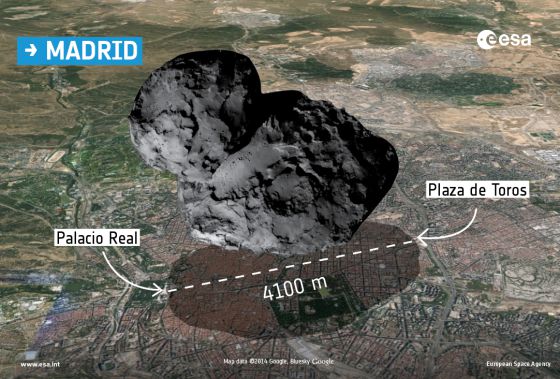
Photograph of Comet 67P / Churyamov-Gerasimenko on the map of Madrid comparing sizes. / ESA / Rosetta / Navcam; Map data © 2014 Google, Bluesky
Scientists and engineers probe Philae were working around the clock to get all the scientific data collected by the robot on the floor of the comet 67P / Churyumov-Gerasimenko and at the same time, the desperate search for strategies that can extend its somewhat life in the place ended up after declining last Wednesday. The main problem, explained the charge of the mission in the European Space Agency (ESA), remained that, being in shadow, the solar panels on the Philae just charge your batteries. But the 10 science instruments on the Philae are running.
The probe came with enough power to run two half days. The limit must be completed sometime this evening or the next morning. To maximize the limited time available, the experts decided to turn the borer Philae , a device for making a hole in the ground (up to 25 cm) and sample to be analyzed on board which would provide crucial information on the composition of the comet. Before finalizing the communication window, this morning, the drill data had reached 22 inches were received. Early in the afternoon, Stefan Ulamec, head of the probe team, said that until the next communication with the robot, scheduled for late in the night and all through the ship Rosetta orbit of the comet, they could not know the results of the drilling. “And there are certain that the on-board batteries have enough power to transmit the data you can get,” he said.
“We do not know exactly where the Philae ” , Ulamec said. The lander had a rough finish to the surface of comet 67P / Churyamov-Gerasimenko 510 million kilometers from Earth. He landed in the target point in a spatial precision maneuver after the ship shed Rosetta . But coming down, not harpoons Philae they should fix there and bounced twice (in the first jump was raised to a mile likewise shifted) soared. On the third landing he fell on the ground, with only two of its three legs in contact with the surface and along rock walls that shade. Therefore, the probe panels are not getting enough sunlight to charge the batteries. In this situation, explained Ulamec, decided to activate the punch, even with the implicit risk of destabilizing the probe
Experts consider the possibility of rotating the probe slightly to receive more sunlight
Despite the unforeseen and the frantic operation of the probe, the enormous satisfaction does not decline or ESA nor between scientific centers participating in the mission. “We Philae on the comet and running,” he said Andrea Accomazzo, flight director at the center ESOC control in Germany. Also specialists from NASA, who contributed three science instruments, were very satisfied. “All of us here are delighted. Congratulations! “They said, from the US, Gordon Johnston and Jeff Grossman, specialists OSIRIS-REx mission NASA prepares to sample an asteroid.
With the information you have submitted the Philae and the Rosetta , experts try to pinpoint the location was the first stop. What is clear is that the place is unfavorable for the problem of the shadow. “We have very little light,” said Valentina Lommats, the German space agency DLR. “If we have communication with the Philae , we will send the commands to be lifted and shifted towards the sun (can rotate 360 degrees and rise without moving the legs); if this works, we would have a chance to use the probe in a few weeks, when the comet is a bit closer to the star, “he told El Pais Lawrence O’Rourke, systems engineer at ESA’s team of Philae , from the control center. He had received six or seven hours of daily illumination, but now one of the panels of the probe receives light one hour and 20 minutes a day (the cometary day lasts 12.4 hours), and another 20 minutes Lommats said.
How will you know that there is no power on board? Simply when the Philae moving to stay, as more data are received.
As for the Rosetta , “is working very well, is solid rock and perfectly maintained communications with the Philae , with a very stable contact, “said Accomazzo
Good luck
The two jumps probe Philae given in the comet’s surface to lie on the floor in the third landing have given scientists more data waiting in touchdown during landing. Lawrence O’Rourke, senior systems engineer for the mission, explains: “We have obtained evidence for multiple sites of the comet, instead of one.” Keep in mind that in the first landing, the probe performed that was already permanently on the ground and activated their systems, although he resumed flying again, and continued to make measurements.
Another unforeseen factor over become advantage: no small rocket had to press the Philae the ground on landing and help fix it to avoid rebound came on. But when the situation does not shoot another fastener to the surface, the harpoons, the first failure played into complicated. “By failing to set the probe to the ground, if it had worked that little rocket Philae would have to turn, instead of falling more or less with their feet to the ground, as he did,” said O ‘Rourke. “So we’ve been lucky with bad luck.”
No comments:
Post a Comment